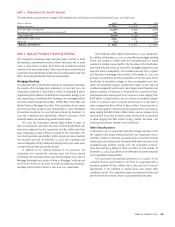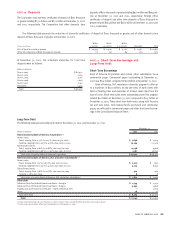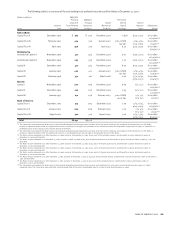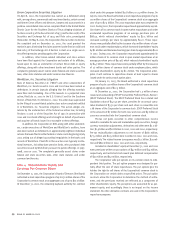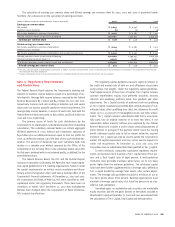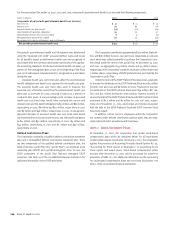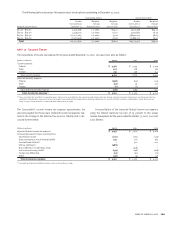Bank of America 2002 Annual Report Download - page 99
Download and view the complete annual report
Please find page 99 of the 2002 Bank of America annual report below. You can navigate through the pages in the report by either clicking on the pages listed below, or by using the keyword search tool below to find specific information within the annual report.
against payments even under extreme stress scenarios. These guaran-
tees are booked as derivatives and marked to market in the trading port-
folio. At December 31, 2002, the notional amount of these guarantees
totaled $19.7 billion. As of December 31, 2002, the Corporation has
never made a payment under these products, and management believes
that the probability of payments under these guarantees is remote.
The Corporation also sells products that guarantee the return of
principal to investors at a preset future date. These guarantees cover a
broad range of underlying asset classes and are designed to cover the
shortfall between the market value of the underlying portfolio and the
principal amount on the preset future date. To manage its exposure, the
Corporation requires that these guarantees be backed by structural and
investment constraints and certain pre-defined triggers that would
require the underlying assets or portfolio to be liquidated and invested
in zero-coupon bonds that mature at the preset future date. The
Corporation is required to fund any shortfall at the preset future date
between the proceeds of the liquidated assets and the purchase price of
the zero-coupon bonds. These guarantees are booked as derivatives
and marked to market in the trading portfolio. At December 31, 2002, the
notional amount of these guarantees totaled $4.1 billion; however, as of
December 31, 2002, the Corporation has never made a payment under
these products, and management believes that the probability of pay-
ments under these guarantees is remote.
In the ordinary course of business, the Corporation enters into
various agreements that contain indemnifications, such as tax indem-
nifications, whereupon payment may become due if certain external
events occur, such as a change in tax law. These agreements typically
contain an early termination clause that permits the Corporation to
exit the agreement upon these events. The maximum potential future
payment under indemnification agreements is difficult to assess for
several reasons, including the inability to predict future changes in
tax and other laws, the difficulty in determining how such laws would
apply to parties in contracts, the absence of exposure limits contained
in standard contract language and the timing of the early termination
clause. Historically, any payments made under these guarantees have
been de minimis. Management has assessed the probability of making
such payments in the future as remote.
The Corporation has entered into additional guarantee agree-
ments, including lease end obligation agreements, partial credit guar-
antees on certain leases, sold risk participation swaps and sold put
options that require gross settlement. The maximum potential future
payment under these agreements is approximately $575 million at
December 31, 2002.
For additional information on recourse obligations related to
mortgage loans sold and other guarantees related to securitizations,
see Note 8 of the consolidated financial statements.
Litigation
In the ordinary course of business, the Corporation and its subsidiaries
are routinely defendants in or parties to a number of pending and
threatened legal actions and proceedings, including actions brought on
behalf of various classes of claimants. In certain of these actions and
proceedings, claims for substantial monetary damages are asserted
against the Corporation and its subsidiaries and certain of these
actions and proceedings are based on alleged violations of consumer
protection, securities, environmental, banking and other laws.
In view of the inherent difficulty of predicting the outcome of
such matters, the Corporation cannot state what the eventual out-
come of pending matters will be; however, based on current knowl-
edge, management does not believe that liabilities, if any, arising
from pending litigation, including the litigation described below, will
have a material adverse effect on the consolidated financial position,
operations or liquidity of the Corporation.
D.E. Shaw Litigation
Following the merger of NationsBank Corporation and BankAmerica
Corporation in September 1998, the Corporation and certain of its offi-
cers and directors were named as defendants in class actions brought
on behalf of persons who purchased NationsBank or BankAmerica
shares between August 4, 1998 and September 30, 1998; persons
who purchased shares of the Corporation between October 1 and
October 13, 1998, and persons who held NationsBank or BankAmerica
shares as of the merger. The claims on behalf of the purchasers and
the persons who held NationsBank shares as of the merger principally
rested on the allegation that the Corporation or its predecessors failed
to disclose material facts concerning a $1.4 billion financial relation-
ship between BankAmerica Corporation and D.E. Shaw & Co. that
resulted in a $372 million charge to the Corporation’s earnings in the
quarter ending September 30, 1998. The claims of the persons who
held BankAmerica shares as of the merger principally rested on the
allegation that the defendants misrepresented a “takeover” of
BankAmerica Corporation as a “merger of equals.”
On November 2, 2002, the United States District Court for the
Eastern District of Missouri (the “Federal Court”), the Court to which
all federal actions had been transferred, entered a final judgment
dismissing the actions with prejudice. The Court entered the judgment
after approving a settlement providing for payment of $333 million to
the classes of purchasers and holders of NationsBank shares and
$157 million to the classes of purchasers of BankAmerica and
Corporation shares and holders of BankAmerica shares (all amounts to
bear interest at the 90-day Treasury Bill Rate from March 6, 2002 to the
date of payment). There remain pending several actions in California
that have been stayed since April 2000, when the Federal Court
enjoined the plaintiffs in those actions from purporting to prosecute
their claims on behalf of a class. Several class members, including two
lead plaintiffs, are appealing from the Federal Court’s judgment to the
United States Court of Appeals for the Eighth Circuit.
BANK OF AMERICA 2002 97




